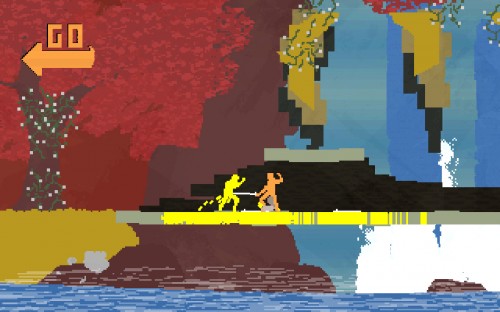 THE ORANGE HUMANOID SKEWERS the yellow character in order move towards the left and move on to the next screen. The yellow character will respawn again later.
THE ORANGE HUMANOID SKEWERS the yellow character in order move towards the left and move on to the next screen. The yellow character will respawn again later.A few weeks ago, I was hanging around with some friends, watching reruns of Mythbusters, bored out of my mind, when my friend asked if I wanted to try this new game, Nidhogg. I was interested, not just out of boredom, but the name. Nidhogg? What does that mean? After some research, I learned that Nidhogg, also known as Níðhöggr, is an ancient Norse dragon that gnaws at a root of the World Tree. The prefix of this name in those times meant losing honor and becoming a villain, which I think fits this game quite well.
Nidhogg centers around two players on opposite sides of the screen. They both start with swords, and if either are hit, they instantly die and are respawned after a few seconds. Now you might think, “this is silly, how can you have a fighting game with a one shot kill, and even when you kill them, it does nothing?” Well, it’s simple. The goal is not to kill your opponent, but to get past them and get to the edge of the screen. You can kill, incapacitate, or simply jump over your opponent in order to get past them and win the game.
The game is minimal, and that’s the style it sticks with the whole way. Your character is a pixelated, single-colored, humanoid, same as your opponent. The stages follow a similar style, with simple colors and pixel art graphics. The stages are not as simple as they appear, however. All four stages have their own special theme that allows for interesting obstacles. The mines have conveyer belts that move the characters on them in a single direction, the forest has tall grass that a character can hide in, the clouds have bridges that disintegrate while a character is on them, and the castle stage is the “pure” area with no special additions.
Each zone feels and looks different, and the screen is never boring, with slick background animations, but you never lose your character in the scene with the brightly colored character palette, which makes them stick out well. The only weird choice is that there is a “win screen” the winner receives where they run in front of a stand of people and are then eaten by a giant worm. This is very weird, but doesn’t take away from the aesthetic of the game, which is an old school arcade look.
Nidhogg not only looks like an arcade game but plays like one. The game centers around two buttons and movement controls like an old school arcade cabinet. On the keyboard, four directional buttons like the arrow keys, or a joystick on a controller moves the character. With the up and down directional controls, the character can raise and lower their sword, which not only allows for a stab over or under the opponent’s sword, but also to parry or block certain strategic maneuvers, such as the roll or dive kick. The first action button controls the ability to jump, while the other allows for attacks. If the sword is level to the ground, a stab can be executed using the attack button. But this isn’t the only attack. If the player is ducking by holding the down control and the attack button is used, a sweep kick can be done. Additionally, if the sword is raised completely above the character’s head by holding up and the attack button is pressed, the sword is thrown.
This simple, pure, combat makes the focus of the game strategy. If your opponent’s sword is low, is it worth throwing your sword and losing your only weapon? Can you roll under the opponent’s sword for a stab? Is it possible to get past the enemy and run towards the goal? Every encounter with the opponent requires these questions to be asked, and with three screens to go through in each stage, there can be no argument by the end over who has won.
Nidhogg comes with a single player mode, a two player quick play mode, a multiple player tournament mode, and an online versus mode. The single player game is a simple circuit, where you must defeat enemies of ever increasing difficulty. Two player quick play allows two people to play a single stage of Nidhogg. Tournament mode gives a predetermined amount of players a bracket where two people compete at each point to decide who is the best at Nidhogg. The final mode, online versus, is the only one I’ve had trouble with. Every time I’ve tried, I’ve gotten into a match my character is unresponsive, but I usually can’t get into a match and the game freezes on the matchmaking screen without a way to quit the game unless I end the program. This is disappointing, but since the game isn’t an online focused experience like Call of Duty or Starcraft, I can forgive it.
When I researched the game, I found that Nidhogg had won multiple awards from different groups as an indie game. I was surprised this flew under my radar. I usually try to look out for games like this, and with such a rich gameplay that inspired me to buy it after playing with a friend, it seems strange to not have a strong following. This is something I intend to correct. For those who enjoy a fun, action packed, retro-arcade game, this is certainly for you. For those who enjoy a casual single player experience, you might want to pass, but for the low price of $14.99, it is hard to go wrong.
